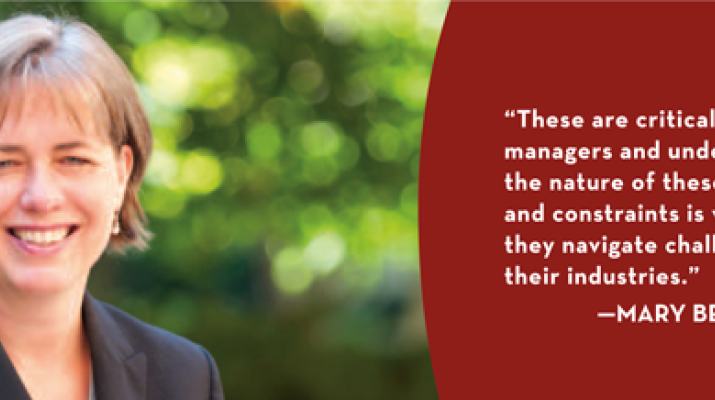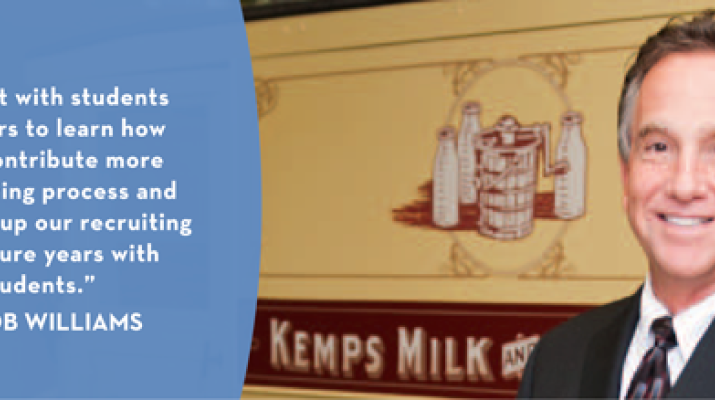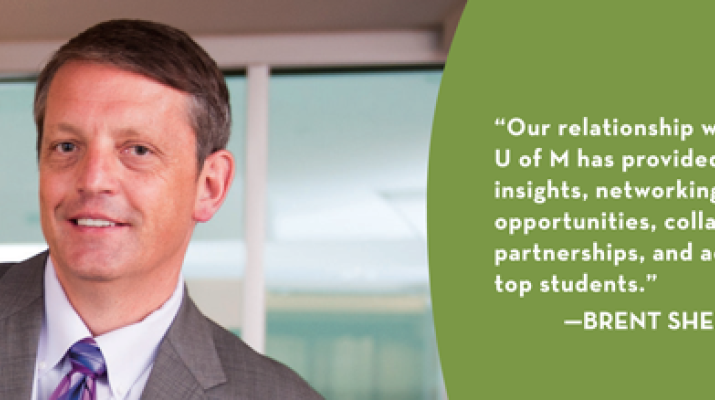
The Nature of Business School Research
Thursday, September 1, 2011

Students benefit from faculty members who are on the cutting-edge of developments in their fields and incorporate these insights into their classrooms.
Groundbreaking research has profound effects both in academia and in the business community.
Research is at the heart of the Carlson School’s mission. The discovery of new insights, ideas, and opportunities is a vital part of the school’s dynamic intellectual community and educational environment.
As scholars, faculty members generate research articles that are published in top academic journals and cited by peers. As business educators, they design their research to address current issues that managers, policymakers, and students face. This has always been a hallmark of the Carlson School.
George John, associate dean of faculty and research and the General Mills/Paul S. Gerot Chair in Marketing, says the Carlson School faculty is highly regarded for its ability to encompass rigor and relevance. “The Carlson School is consistently ranked in the top 20 business schools in the world based on its research publications in leading journals,” he says. “Several academic departments rank in the top 10 of their respective fields. And one of the influential scholarly journals in information management, MIS Quarterly, is also published here. Maintaining research excellence is a marathon. Not only does it take faculty members more than five years from inception to final publication of articles, the top journals publish fewer than 15 percent of submitted papers. Nevertheless, we punch above our weight in research.
“This outstanding scholarship powerfully enhances the school’s reputation and strengthens its connections with corporate partners and collaborators. Students benefit from faculty members who are on the cutting-edge of developments in their fields and incorporate these insights into their classrooms. They also derive a tangible benefit from the reputational capital embedded into their diplomas.”
A HISTORY OF RESEARCH EXCELLENCE
Over the decades, Carlson faculty members have built the foundation for the business school’s renowned research reputation. A few milestones include:
- E. Jerome McCarthy, who received his PhD from the University of Minnesota’s School of Business Administration in 1958, co-authored the iconic marketing textbook, Basic Marketing: A Managerial Approach. The book introduced the 4-Ps model of marketing (product, place, price, promotion) that today is used the world over; its first edition was published in 1960.
- In the 1980s, Andy Van de Van, strategic management and organization professor and Vernon H. Heath Chair of Organizational Innovation and Change, led a groundbreaking program of work on innovation as a management process. He directed the Minnesota Innovation Research Program which engaged 30 faculty members and doctoral students in tracking 14 different kinds of innovations from concept to implementation.
- In his 1983 Journal of Marketing article, “Applying Financial Portfolio Theory to Product Portfolio Decision: An Empirical Study,” Richard Cardozo, marketing and logistics management professor, applied risk-return portfolio analysis, as originally developed in economics and finance, to product-line decisions. He pioneered the use of direct estimates of return and risk on portfolio models for new and existing products.
- In the 1990s, John Dickhaut and Kevin McCabe, who were accounting department faculty, devised the Investment/Trust game in their 1995 article, “Trust, Reciprocity and Social Norms,” published in Games and Economic Behavior. The game is a highly reliable laboratory protocol that opened up the field of study of trust in financial interactions between strangers. Not surprisingly, the paper has been cited over a thousand times and their method has been used in hundreds of studies by other scholars world-wide.
This pioneering intellectual spirit continues today in the Carlson School’s faculty members and graduate students. “A key reason why business school research mirrors rigor and relevance is that the PhD students bring incredibly strong backgrounds in mathematics, engineering, psychology, economics, and statistics to their doctoral work in business,” says John. “Only about five to seven percent of applicants are admitted. Thus, they have an in-depth understanding of the theoretical and the practical as they approach their research as future business school faculty members.”
John Budd, Industrial Relations Land Grant Chair, Department of Work and Organizations, adds that business school research profoundly impacts students pursuing bachelor’s and master’s degrees. “For undergraduate and graduate students, it improves their understanding of how business works and deepens their recognition of how businesses and other organizations impact various aspects of society.”

These are critical topics for managers and understanding the nature of these barriers and constraints is vital as they navigate challenges in their industries.
THE EXCELLENCE CONTINUES
The Carlson School’s vibrant research environment helps attract renowned scholars and students, including experienced faculty members and sought-after PhD graduates. Mary Benner, associate professor of strategic management and organization, believes that the most important discoveries in business schools draw from a rich background of theory and research in disciplinary fields like economics, psychology, and sociology, as well as careful statistical and experimental methods. “Business school research aims at questions that are not answered within those disciplines, but that are central to management,” she says. “Of course great research also advances scholarship, a requirement for publishing in the top academic journals.”
Benner’s research explores how firms innovate and adapt to technological change. “In sum, my research suggests that both internal factors, like the adoption of process management programs, and external factors, such as analysts and shareholders, create important pressures and constraints on how firms innovate,” she says. “These are critical topics for managers and understanding the nature of these barriers and constraints is vital as they navigate challenges in their industries.”
Benner adds that the large number of Fortune 500 companies headquartered in the Twin Cities provides faculty members with opportunities to interact with many top-level managers. “This increases our understanding of the challenges and issues they face and gives us an opportunity to make our research relevant and timely,” she says. “I have been involved in discussions and other efforts concerning innovation – related to my research – at companies like Medtronic and General Mills, among others.”
THE SCIENTIFIC PROCESS AND NEW KNOWLEDGE
Like most academic research, work at the Carlson School generally follows the scientific method which involves forming a hypothesis, gathering and analyzing data, and confronting the hypothesis with primary and secondary data. Typically, primary data is generated “de novo” by researchers for studies aiming to understand complex, emerging phenomena in their natural settings; while secondary data has already been collected by others on similar or related phenomena.
K.K. Sinha, operations and management science professor and Mosaic Company Professor of Corporate Responsibility, conducts many of his studies using both primary and secondary data. Understanding the growing disparities in the delivery of quality health care, both globally and in the U.S., is one of the primary key questions of his research program. He and his research team are investigating the design of health care supply chains that link the development of care to the delivery of care in underserved communities. His research team has collected primary data via interviews with people in a health care delivery network in a remote province in China where the demand for pediatric congenital heart disease care far exceeds the supply for such care; and also at primary care clinics in urban areas of Minnesota with growing inequities in care delivery due to changing demographics and socio-economic conditions.
“During these interviews, we were meticulous and rigorous in how we recorded, collected, and analyzed the data,” he says. The project also used existing data (secondary data) on the health care supply chain as well as the supply and demand for services. The research led to the development and testing of a health care delivery model that illustrates how the affordability, accessibility, and awareness of a type of care are inter-related with the volume and quality of the care delivered. In addition, the researchers created and assessed a framework that shows how information technology capabilities can reduce disparities in care delivery.
Sinha says he finds satisfaction in tackling real-world problems like gaps in the supply and demand for health care services. “You realize the limitations of existing theories and practices,” he says. “Through applied research, you have the opportunity to play a role in shaping future tactics, strategies, and policies that might produce better outcomes. While gathering data and testing ideas in the trenches, you can’t lose sight of the bigger picture. You have to constantly straddle between the trees and the forest.”
Beyond advancing research and practice, Sinha believes that the projects inspired by complex, real-world problems provide opportunities for mentoring and training doctoral students. The Carlson School has a strong PhD program whose graduates go on to become business school faculty at major universities in the U.S. and abroad. “My research endeavors have helped me become an effective teacher in the MBA and undergraduate programs as well,” he says. “I make it a point to introduce students to the contemporary issues relevant to course topics, and share novel insights gained from my research projects that they can apply as they advance in their careers.”

We have met with students and professors to learn how Kemps can contribute more to their learning process and hope to step up our recruiting efforts in future years with graduating students.
Can scholarly research make an impact in the real business world? Arthur Hill, associate dean for MBA Programs, who holds the John and Nancy Lindahl Professorship for Excellence in Business Education, helped Kemps, located in St. Paul, Minn., implement a Lean Sigma process improvement program that has realized savings of $15 million over the last five years.
These insights arose when Hill and his research collaborators teamed with a large technology manufacturer headquartered in Minnesota to study the linkages between the suppliers’ performance and process improvement program practices. During the study, Hill and his team of Carlson School researchers asked the manufacturer’s commodity managers to score the performance of their suppliers and then surveyed the suppliers about their process improvement program practices.
The research concluded that the three keys to a successful process improvement program were (1) disciplined project management, (2) strategic project selection, and (3) a leadership development view of a process improvement program. To their surprise, they found that disciplined project management led to better project selection and that the single best predictor of success for a process improvement program was the degree to which the organization used the program to develop future leaders. Hill reports that, “As a result, I stressed the importance of disciplined project management and leadership development as Kemps launched its Lean Sigma initiative in 2006.”
Bob Williams, vice president of operations for Kemps, says the Lean Sigma initiative has driven the execution of over 40 projects since 2006. “We have exposed more than 200 Kemps employees to project management, specifically the five-step DMAIC (define, measure, analyze, improve, control) process,” he says. “We use the Lean Sigma foundation as the basis for all project management at Kemps. There are now 15 trained project managers, with 12 trained in DMAIC, and we have about 10 projects in the active state at any one time. This is a significant resource commitment for a company with 250 white-collar employees.” Williams reports that “Art’s research has been the foundation for our Lean Sigma program – and has taught us to be very careful in selecting projects, managing them in a disciplined way, and developing our people along the way.”
Williams says that Kemps has also benefitted from his involvement on the Supply Chain and Operations Board of Advisors at the Carlson School. “I have connected with other business leaders in the community, listened to student presentations, and participated in small- group discussions,” he says. Kemps plans to increase its involvement with the Supply Chain and Operations Board of Advisors during 2011-12. “We have met with students and professors to learn how Kemps can contribute more to their learning process and hope to step up our recruiting efforts in future years with graduating students,” Williams says.

Our relationship with the U of M has provided research insights, networking opportunities, collaborative partnerships, and access to top students.
CONNECTING SCHOLARS AND MANAGERS
Company participation on the Carlson School’s research advisory boards, research centers, and institutes is a win-win for academics and businesses. Researchers gain a current perspective on pressing business issues and feedback from managers on the relevance of current research. Businesses benefit from learning about the latest knowledge in the field.
Brent Sherwin, senior vice president, Sales Operations and Strategy, Schwan’s Consumer Brands North America, Inc., in Bloomington, Minn., is an advisory board member for the Institute for Research in Marketing. He says that understanding and leveraging the research in marketing coming out of the Carlson School has tremendous value for companies like Schwan’s. “Our relationship with the U of M has provided research insights, networking opportunities, collaborative partnerships, and access to top students. Cutting-edge insights about in-store shopper behavior provide us with a competitive advantage in a challenging economy and positively influence our strategy decisions,” he says.
Schwan’s is currently working with Carlson School doctoral students on research projects that address specific company needs. “The research has saved us money by allowing us to better direct resources,” Sherwin says. “In addition, my managers have gained from designing and managing the projects with doctoral students. An initial project determined the value and impact of roll-around freezer bunkers and identified how sales varied by product, location in store, competitor activity, and other factors. A second study determined the probable returns and breakeven points of assuming category captain roles for some of our major accounts.”
Wayne Mueller, director of the Institute for Research in Marketing, says the partnership and projects with Schwan’s are providing the Institute, researchers, professors, and students with an incubation lab offering real-world data and processes. “This direct connection to a company lends credibility to our work and helps us focus our research efforts,” he says. “We are able to come forward together with new ideas and areas to jointly explore that provide insights and benefits to both organizations. Our relationship with Schwan’s exemplifies what the Institute hopes to accomplish with all its advisory board members.”
COMPLEX ISSUES DEMAND COLLABORATIVE RESEARCH
Working partnerships between researchers and business leaders are one way to ensure that current studies are relevant to companies. But what does it take to tackle business issues that impact society, government, and the greater good? In his book, Engaged Scholarship, Professor Andrew Van de Ven argues that collaborative, multi-perspective research is needed to solve significant real-world problems and directly impact public policy.
The book advocates for engaged scholarship: research that represents diverse perspectives and encourages collaboration between academics, business practitioners, clients, and other stakeholders. “Traditional academic research deals in abstractions and generalities, often yielding broad conclusions,” Van de Ven says. “Closing the gap between theory and practice could shed light on some of the most important challenges of our times.”
Whether studying issues in the world’s most remote regions or largest economies; helping managers develop effective strategies for strengthening profitability, quality, and innovation; or proposing ideas that stimulate academic inquiry; Carlson School faculty members make a difference. Through their research, they advance knowledge, help managers make informed decisions, shape new policies, and help businesses understand and respond to change.
Centers and Institutes Link Research with Real Life
Through the Carlson School’s research centers and institutes, faculty members – and sometimes business students – work hand-in-hand with industry leaders to identify and solve pressing business issues. Most have advisory boards or corporate sponsors that provide context to new knowledge and ideas. A key objective is communicating research results to the media, business community, and academic peers through outreach events, white papers, and news stories. Each center and institute is described below.
Center for Human Resources and Labor Studies (CHRLS) – The center is an international leader in human resources and industrial relations education and research and is dedicated to scholarly investigation and dissemination of knowledge. It offers a specialized reference library, research institute, alumni association, advisory board, Labor Education Service, and the annual HR Tomorrow Conference in April.
Center for Integrative Leadership (CIL) – The CIL is dedicated to examining and advancing a new vision for cross-sector leadership to tackle the challenging issues of our time. It engages in collaborative teaching, community outreach, and research initiatives with other University centers and external community partners. The Carlson School and the Hubert H. Humphrey School of Public Affairs share the center’s oversight.
Center for International Business Education and Research (CIBER) – The Carlson School’s CIBER is one of 33 centers nationwide designed to increase the country’s capacity for international understanding and economic enterprise. It serves as a regional resource for businesses, educators, researchers, and students.
Gary S. Holmes Center for Entrepreneurship – To inspire and educate the next generation of entrepreneurs, the Holmes Center provides teaching, research, and outreach programs. It leads entrepreneurship and experiential courses for undergraduate and graduate students; sponsors outreach activities like the Minnesota Cup competition and Junior Entrepreneurs of Minnesota; and engages the entrepreneurial business community through mentorships, internships, and business hatchery programs.
Institute for Research in Marketing – The institute leverages the expertise of marketing faculty and an advisory board of practitioners from leading corporations to foster rigorous, relevant research that improves the science and practice of marketing. It reaches out to marketing executives, government officials, students, alumni, and the press through conferences, a speaker series, outreach meetings, and topical white papers.
Joseph M. Juran Center for Leadership in Quality – The center is a repository for past developments in the field of leadership in quality, as well as a generator of new research, new ideas, and new scholars. It serves as a resource to leaders, scholars, and students through a fellowship program supporting doctoral research and a continuing program of research.
Management Information Systems Research Center (MISRC) – By providing a link between the MIS faculty and the business community, the center disseminates leading-edge thinking about the MIS field, develops new curriculum, and facilitates applied research. The center disseminates research findings through its seminar series and a working paper series. It also publishes MIS Quarterly, one of the leading peer-reviewed scholarly journals in the field.
Medical Industry Leadership Institute (MILI) – The institute puts executives, physicians, students, and academic leaders in touch with the latest trends in the medical industry. To create new avenues for collaboration, education, and research, MILI builds on faculty strengths; draws on the University’s scientific, technical, policy, legal, and ethics expertise; and leverages medical industry firms in Minnesota. It offers outreach events, access to faculty research and lifelong learning programs, and opportunities to network with industry leaders.
Strategic Management Research Center – The center works with the business community to provide a supportive environment for the study, generation, and dissemination of knowledge about key strategic management issues to managers, consultants, students, and researchers. It hosts presentations by leading scholars and alumni conferences.